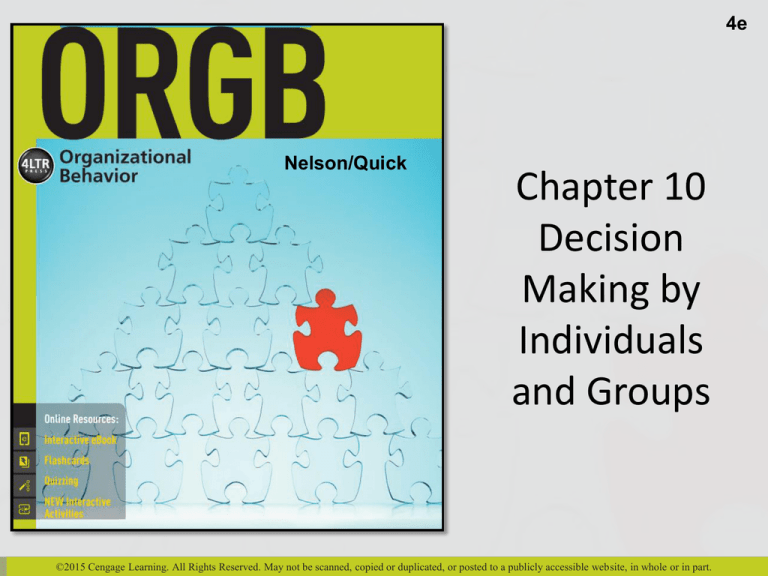
4e
Nelson/Quick
Chapter 10
Decision
Making by
Individuals
and Groups
©2015 Cengage Learning. All Rights Reserved. May not be scanned, copied or duplicated, or posted to a publicly accessible website, in whole or in part.
Learning Outcomes
Identify the steps in the decision-making process
Describe various models of decision making
Discuss the individual influences that affect decision
making
Explain how groups make decisions
Describe the role culture plays in decision making
Explain how organizations can improve the quality
of decisions through participation
©2015 Cengage Learning. All Rights Reserved. May not be scanned, copied or duplicated, or posted to a publicly accessible website, in whole or in part.
2
Figure 10.1 - Decision-Making
Process
©2015 Cengage Learning. All Rights Reserved. May not be scanned, copied or duplicated, or posted to a publicly accessible website, in whole or in part.
3
Effective Decision
Timely decision that meets a desired
objective and is acceptable to those
individuals affected by it
©2015 Cengage Learning. All Rights Reserved. May not be scanned, copied or duplicated, or posted to a publicly accessible website, in whole or in part.
4
Rational Model
Rationality: Logical, step-by-step approach to
decision making, with a thorough analysis of
alternatives and their consequences
Assumptions
Outcome will be completely rational
Decision maker uses a consistent system of
preferences to choose the best alternative
Decision maker is aware of all alternatives
Decision maker can calculate the probability of
success for each alternative
©2015 Cengage Learning. All Rights Reserved. May not be scanned, copied or duplicated, or posted to a publicly accessible website, in whole or in part.
5
Bounded Rationality
Suggests that there are limits to how rational a
decision maker can actually be
Assumptions
Managers select the first alternative that is
satisfactory
Managers recognize that their conception of the
world is simple
Managers are comfortable making decisions without
determining all the alternatives
©2015 Cengage Learning. All Rights Reserved. May not be scanned, copied or duplicated, or posted to a publicly accessible website, in whole or in part.
6
Bounded Rationality
Managers make decisions by rules of thumb or
heuristics
Heuristics: Shortcuts in decision making that save
mental activity
Managers satisfice
Satisfice: To select the first alternative that is good
enough, because the costs in time and effort are too
great to optimize
©2015 Cengage Learning. All Rights Reserved. May not be scanned, copied or duplicated, or posted to a publicly accessible website, in whole or in part.
7
Figure 10.2 - The Z Problem-Solving
Model
©2015 Cengage Learning. All Rights Reserved. May not be scanned, copied or duplicated, or posted to a publicly accessible website, in whole or in part.
8
Factors that Influence Decision
Making
Comfort with risk
• Risk aversion: Choosing options with fewer risks and less
uncertainty
• Depends on individual tendencies and organizational factors
Cognitive style
• Individual’s preference for gathering information and
evaluating alternatives
Personality, attitudes and values
• Influence decision making
©2015 Cengage Learning. All Rights Reserved. May not be scanned, copied or duplicated, or posted to a publicly accessible website, in whole or in part.
9
Individual-Organization Fit
Results in high creative performance is highest
Types of creativity
Responsive
Expected
Contributory
Proactive
©2015 Cengage Learning. All Rights Reserved. May not be scanned, copied or duplicated, or posted to a publicly accessible website, in whole or in part.
10
Group Decision Making
Synergy: Positive force that stimulates new
solutions to problems through mutual influence and
encouragement within the group
Social decision schemes: Rules that determine final
group decisions
Majority-wins rule
Truth-wins rule
Two-thirds-majority rule
First-shift rule
©2015 Cengage Learning. All Rights Reserved. May not be scanned, copied or duplicated, or posted to a publicly accessible website, in whole or in part.
11
Limits of Group Decision Making
Groupthink: Deterioration of mental efficiency, reality
testing, and moral judgment resulting from pressures
within the group
• Conditions that encourage groupthink
• High cohesiveness
• Making highly consequential decision
• Time constraints
Group polarization: Tendency for group discussion to
produce shifts toward more extreme attitudes among
members
• Occurs as a result of the:
• Social comparison approach
• Persuasive arguments view
©2015 Cengage Learning. All Rights Reserved. May not be scanned, copied or duplicated, or posted to a publicly accessible website, in whole or in part.
12
Group Decision Techniques
Brainstorming
• Generating multiple ideas on a given subject while suspending
evaluation until all the ideas have been suggested
Nominal group technique (NGT)
• Structured approach to group decision making that focuses on
generating alternatives and choosing one
Devil’s advocacy
• A group or individual is given the role of critic during decision making,
helps prevent groupthink
Dialectical inquiry
• Debate between two opposing sets of recommendations
©2015 Cengage Learning. All Rights Reserved. May not be scanned, copied or duplicated, or posted to a publicly accessible website, in whole or in part.
13
Participative Decision Making
Decision making in which individuals who are
affected by decisions influence the making of those
decisions
Buffers employees from the negative experiences of
organizational politics
Increases employee creativity, job satisfaction, and
productivity
©2015 Cengage Learning. All Rights Reserved. May not be scanned, copied or duplicated, or posted to a publicly accessible website, in whole or in part.
14
Foundations for Participation
and Empowerment
Organizational perquisites
Supportive organizational culture and a teamoriented work design
Individual perquisites
Capability to become psychologically involved in
participative activities
Motivation to act autonomously
Capacity to see the relevance of participation for
one’s own well-being
©2015 Cengage Learning. All Rights Reserved. May not be scanned, copied or duplicated, or posted to a publicly accessible website, in whole or in part.
15







